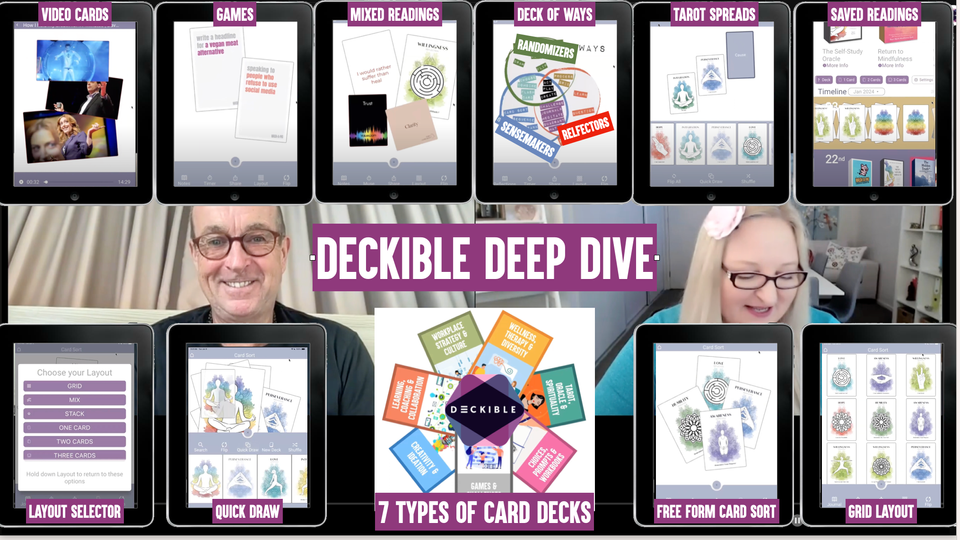Deep Dive - How to Video Guide for using a Digital Card Deck App like Deckible

Deckible is the world's premier marketplace for digital card decks.
There's a reason. We do more, we do it better. we do it easier. And it looks and feels amazing. Watch this video to see what we mean.
600+ decks to choose from in the Deckible Marketplace.
We dive into all the different ways to use Deckible from free form selection to card sorts to tarot spreads and more.
We showcase the power of the layout feature. And show how to do a card sort.
We cover the 7 segments of card decks. There literally is a card deck for every moment.
WORKPLACE STRATEGY & CULTURE
TAROT, ORACLE & SPIRITUALITY
WELLNESS,THERAPY & DIVERSITY
CREATIVITY & IDEATION
LEARNING, COACHING & COLLABORATION
CHOICES, PROMPTS & WORKBOOKS
GAMES & CHALLENGES
Deck of Ways: 21 Ways to use Card Decks
Get your free copy here
https://www.deckible.com/marketplace/free
Here are the 21 ways.

Randomizers, Sensemakers and Reflectors
People often have not appreciated the ways people use card decks.
Some people think decks are all about Tarot and that is just one piece of the totally puzzle.
Decks can be secular and non secular
Decks can be used personally or professionally
Decks can be used alone or in collaboration.
21 Ways
Shuffle :Mix the cards into a random order.
Deal : Give a number of cards to each of the participants.
Fli : Flip the card to cycle to the next face. Digitally there can be more than two sides.
Question: Use the cards to ask questions and get hyper curious about the problem/ opportunity.
Reflect: Look back on your prior actions and thoughts. How does this feel today? It's likely things have changed.
Rank: Put things in sequence from least to most. What metric will you use to rank the cards? You can also pinch and zoom cards to reflect their priority.
Combine: Pull two or more cards from one or more decks. What does that unique combination mean? How would that make you think differently?
Create: Create your own deck as a building block to fresh thinking. Create a deck of options to offer up to your peers/collaborators for their consideration.
Match: Pair up cards that go together or can be combined in interesting ways. What is the connection? This can be used as a memory game or an exercise to see how people think.
Card Sort: Divide the cards into a pile or group. Yes and No. Or Yes, No, Maybe. Group the cards as you see fit. Create your own labels.
Draw: Pull one or more random cards from the deck.
Journal: What do(es) these card(s) suggest to you? Scribble, take notes, draw or journal. What do the cards make you think and feel?
Learn: We all learn differently. In addition to allowing you to choose and arrange, the cards also provide you with more information. Read, Listen or Watch. Choose from the options that speak to your learning style. What is your learning style?
Sequence: Put the cards into order like a project plan or a Gantt chart. A then B then C. Consider which is the best sequence to complete these tasks/options.
Act: Do something. Take action. Get inspired by a card. Do something random,new or inspiring.
Process: When solving a problem, you move through a process. Diverging, evaluating and converging.
- Diverge. Go wider. Consider more options
- Evaluate. Things get considered and options emerge
- Converge. Things get narrower. Focus in on possible solutions. Be ready to present your findings"
Choose: Pick a card. Choose the card that speaks to you. Do this blind or with the cards flipped. Your choice.
Play: Have fun with the cards. Make up a game. Create meaning, make sense or chaos.
Grid / Tile: Layout the cards like tiles in a grid to see what options exist. You can also explore if any options are missing and consider creating a deck via "Create".
Quadrant: Pick a quadrant—there are many (eg. Boston Consulting Matrix, Johari Window etc.) Place cards as you see fit in the chosen layout. Reject cards that don't fit. Tarot spreads are a form of quadrant.
Uses: This deck defines the 21 ways we use card decks. The ways are split into three types of activity: Randomizers, Sensemakers and Reflectors.
Challenges: 7 days, 30 days, 100 days. We've all joined a challenge. Cards are perfect for delivering your daily action as a card.
Flash Cards: We use flash cards to help with learning and recall. The content on the card provides both knowledge and the ability to test your memory.